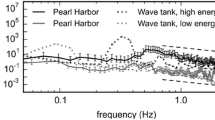Abstract
This paper describes a flume tank in which the various physical and behavioural conditions encountered by swarming macroplankton can be manipulated, and a mathematical stereophotographic technique, for use in the calculation of the three-dimensional co-ordinates of individual organisms within the swarms. The mathematical model incorporates the Direct-Linear Transformation equation which describes the position of the object and its image in relation to the camera-perspective centre of the photographic system. Combining this equation with a modified light-ray tracement technique to solve for the passage of light through a three-media environment, the actual three-dimensional co-ordinates of the individual organisms and subsequently their inter-individual distances, bearings and angles of elevation may be derived. The distances between adjacent animals can be measured to an accuracy of 0.24 mm (SD=0.21) using this photogrammetric technique. The design of the flume tank allows for the manipulation of water current speed and flow patterns, substrate, and light intensity. Six species of mysid and one species of euphausiid have been induced to swarm in the flume tank. The conditions required to induce swarming and schooling in the laboratory are described. The inter-individual distances, bearings and angles of elevation have been calculated for Paramesopodopsis rufa, Anisomysis mixta australis, Australerythrops paradicei (Crustacea: Mysidacea) and Nyctiphanes australis (Crustacea: Euphausiacea) using the stereophotographic technique.
Similar content being viewed by others
Literature cited
Arnold, G. P.: A flume for behaviour studies of marine fish. J. exp. Biol. 51, 39–47 (1969)
Cullen, J. M., E. Shaw and H. A. Baldwin: Methods for measuring the three-dimensional structure of fish schools. Anim. Behav. 13, 534–543 (1965)
Clutter, R. I.: The microdistribution and social behaviour of some pelagic mysid shrimps. J. exp. mar. Biol. Ecol. 3, 125–155 (1969)
Dambach, M.: Vergleichende Untersuchungen über das Schwarmverhalten von Tilapia-Jungfischen (Cichlidea). Z. Tierpsychol. 20, 267–296 (1963)
Dill, L. M., R. L. Dunbrack and P. F. Major: A new stereophotographic technique for analyzing the three-dimensional structure of fish schools. Envir. Biol. Fish. 6, 7–13 (1981)
Hasegawa, E. and H. Tsuboi: A study of the 3'd structure of marine fish schools by the stereo method with two cameras. La Mer (Bull. Soc. franco-jap. Océanogr.) 19, 179–184 (1981)
Hellawell, J. M., H. Leatham and G. I. Williams: The upstream migratory behaviour of salmonids in the River Frome, Dorset. J. Fish Biol 6, 729–744 (1974)
Hohle, D. I. J.: Reconstruction of the underwater object. Photogramm. Engng. 37, 948–954 (1971)
Hunter, J. R.: Procedure for analysis of schooling behaviour. J. Fish. Res. Bd Can. 23, 547–562 (1966)
Karara, H. M. and Y. I. Abdel-Aziz: Accuracy aspects of nonmetric imageries. Photogramm. Engng 40, 1107–1117 (1974)
Katz, L. C., M. J. Potel and R. J. Wasserug: Structure and mechanisms of schooling in tadpoles of the clawed frog, Xenopus laevis. Anim. Behav. 29, 20–33 (1981)
Kils, U.: The swimming behaviour, swimming performance and energy balance of antarctic krill, Euphausia superba. S.C.A.R. Biomass Rep. Ser. 30, 70–89 (1981)
Koltes, K. H.: Temporal patterns in the three-dimensional structure and activity of schools of the Atlantic silverside Menidia menidia. Mar. Biol. 78, 113–122 (1984)
Major, P. F. and L. M. Dill: The 3-dimensional structure of airborne bird flocks. Behavl Ecol. Sociobiol. 4, 111–112 (1978)
Marzan, G. T. and H. M. Karara: A computer program for direct linear transformation solution of the collinearity condition, and some applications of it. In: Proceedings of the Symposium on Close-Range Photogrammetric Systems. Campaign, Illinois, USA, pp 420–476. Ed. by H. M. Karara. Falls, Church, Virginia: American Society of Photogrammetry 1975
Moffitt, F. H. and E. M. Mikhail: 3′ dimensional transformation. In: Photogrammetry, 3rd ed. pp 371–374. New York: Harper & Row 1980
Partridge, B. L.: The effect of school size on the structure and dynamics of minnow schools. Anim. Behav. 28, 68–77 (1980)
Partridge, B. L. and T. J. Pitcher: The sensory basis of fish schools: relative roles of lateral lines and vision. J. comp. Physiol. 135, 315–325 (1980)
Partridge, B. L., T. Pitcher, J. M. Cullen and J. Wilson: The threedimensional structure of fish schools. Behavl Ecol. Sociobiol. 6, 277–288 (1980)
Pitcher, T. J.: The three-dimensional structure of schools of the minnow, Phoxinus phoxinus (L.). Trans. Am. Fish. Soc. 102, 840–843 (1973)
Pitcher, T. J.: A periscopic method for determining the 3-dimensional positions of fish in schools. J. Fish. Res. Bd Can. 32, 1533–1538 (1975)
Potel, M. J. and R. J. Wasserug: Computer tools for the analysis of schooling. Envir. Biol. Fish. 6, 15–19 (1981)
Smith, J. A. and A. J. Dartnall: Boundary layer control by water pennies (Coleoptera: Psephenidae). Aquat. Insects 2, 65–72 (1980)
Svoboda, A.: Simulation of oscillating water movement in the laboratory, cultivation of shallow water sedentary organisms. Helgoländer wiss. Meeresunters. 20, 676–684 (1970)
Symons, P. E. K.: Estimating distances between fish schooling in an aquarium. J. Fish. Res. Bd Can. 28, 1805–1806 (1971)
Trivellato, D. et H. Décamps: Dipositif expérimental pour l'étude du comportement d'espèces benthiques en eau courante. Annls Limnol. 7, 145–155 (1971)
Vogel, S. and M. LaBarbera: Simple flow tanks for research and teaching. BioSci. 28, 638–643 (1978)
Walesby, N. J.: Some aspects of the locomotor activity patterns of Praunus flexuosus and schooling behaviour of Neomysis integer, 137 pp. M.Sc. thesis, University College of North Wales, UK 1973
Wasserug, R. J., A. M. Lum and M. J. Potel: An analysis of school structure for tadpoles (Anura: Amphibia). Behavl Ecol. Sociobiol. 9, 15–22 (1981)
Zeldis, J. R. and J. B. Jillett: Aggregation of pelagic Munida gregaria (Fabricius) (Decapoda, Anomura) by coastal fronts and internal waves. J. Plankton Res. 4, 839–857 (1982)
Zelickman, E. A.: Group orientation in Neomysis mirabilis (Mysidacea: Crustacea). Mar. Biol. 24, 251–258 (1974)
Author information
Authors and Affiliations
Additional information
Communicated by G. F. Humphrey, Sydney
Rights and permissions
About this article
Cite this article
O'Brien, D.P., Tay, D. & Zwart, P.R. Laboratory method of analysis of swarming behaviour in macroplankton: combination of a modified flume tank and stereophotographic techniques. Mar. Biol. 90, 517–527 (1986). https://doi.org/10.1007/BF00409272
Accepted:
Issue Date:
DOI: https://doi.org/10.1007/BF00409272




